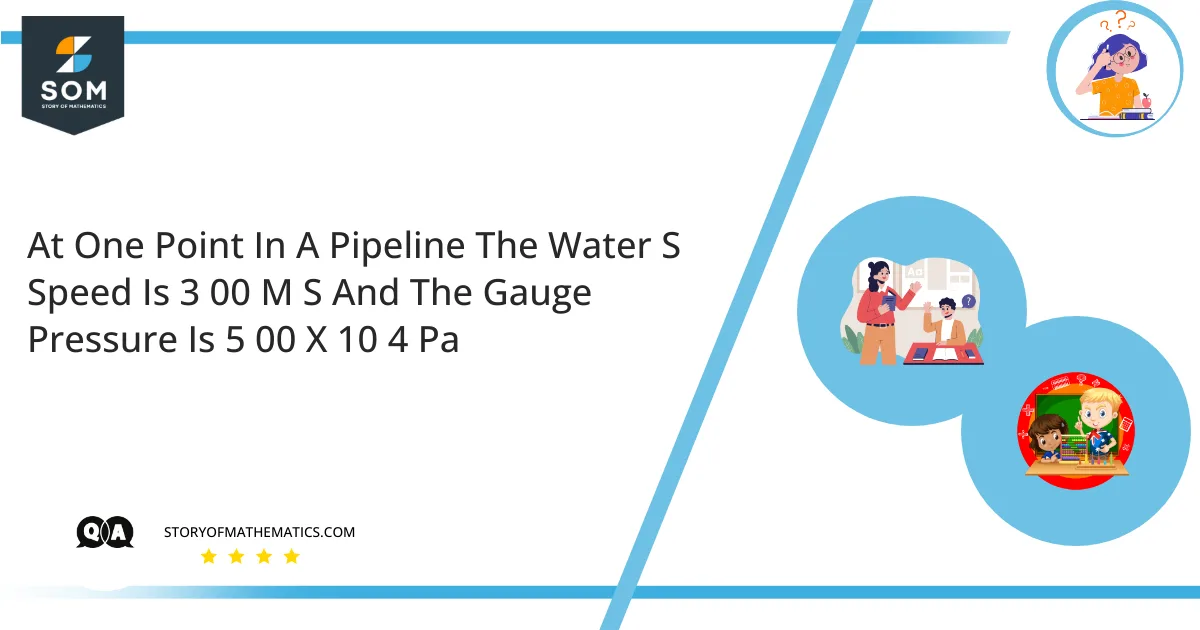
The main objective of this question is to find the gauge pressure at the second point in the pipeline using Bernoulli’s equation.
The continuity equation states that the product of the pipe’s cross-sectional area and fluid speed at any instant along the pipe must be constant. This product is equal to the flow rate or volume flow per second. The continuity equation is derived by assuming that the pipe only has one exit and one entry, and the fluid is non-viscous, incompressible, and steady.
When the static pressure or potential energy of the fluid decreases, an increase in the fluid speed is observed. This phenomenon is known as Bernoulli’s principle in fluid dynamics. Bernoulli’s principle can be applied to different types of fluid flow, yielding different forms of Bernoulli’s equation. Bernoulli’s Equation is a representation of the energy conservation principle that applies to fluid flow. The qualitative behavior commonly referred to as Bernoulli’s effect is the decrease in fluid pressure in areas where the velocity of the flow is increased. The decrease of pressure in a flow path compression may appear counter-intuitive, but it becomes less when the pressure is considered to be energy density.
Expert Answer
Let $d_1$ and $d_2$ be the diameter of the first and second points in the pipeline, respectively. Let $A_1$ and $A_2$ be the area of two cross-sections. Since the diameter at the second point is twice the diameter at the first point, therefore:
$d_2=2d_1$
Also, $A_1=\pi d^2_1$
and $A_2=\pi d^2_2$
$A_2=\pi (2d_1)^2$
$A_2=4\pi d^2_1$
Or, $A_2=4A_1$
To determine the relation between the velocities, use the continuity equation:
$v_1A_1=v_2A_2$
$\implies v_2=\dfrac{v_1A_1}{A_2}$
Since, $A_2=4A_1$
So, $v_2=\dfrac{v_1}{4}$
Now, using the Bernoulli’s equation:
$p_1+\rho g x_1+\dfrac{1}{2}\rho v^2_1=p_2+\rho g x_2+\dfrac{1}{2}\rho v^2_2$
Since, we have to find the pressure at the second point so, rearrange the equation as:
$p_2=p_1+\rho g(x_1-x_2)+\dfrac{1}{2}\rho(v^2_1-v^2_2)$
Substituting $v_2=\dfrac{v_1}{4}$ in the above equation:
$p_2=p_1+\rho g(x_1-x_2)+\dfrac{1}{2}\rho\left(1-\dfrac{1}{16}\right)v^2_1$
$p_2=p_1+\rho g(x_1-x_2)+\dfrac{1}{2}\rho\left(\dfrac{15}{16}\right)v^2_1$
$p_2=p_1+\rho g(x_1-x_2)+\dfrac{15}{32}\rho v^2_1$
Here, $p_1=5.00\times 10^4 \,Pa$, $\rho=1000\,kg/m^3$, $g=9.8\,m/s^2$, $x_1-x_2=11.0\,m$, and $v^2_1=3.00\,m/s$, so:
$p_2=5.00\times 10^4 +(1000)(9.8)(11.0)+\dfrac{15}{32}(1000)(3.00)^2$
$p_2=162\,kPa$
Example
A tank filled with water is pierced by a bullet from one side. The height of the tank is $40\,m$ and the hole is $3\,m$ above the ground. Find the velocity of water flowing out of the hole. Assume the top of the container as point $1$ and the hole as point $2$ where both of them are open to the atmosphere.
Solution
Since both the points are open to atmosphere, therefore the Bernoulli’s equation:
$p_1+\rho g x_1+\dfrac{1}{2}\rho v^2_1=p_2+\rho g x_2+\dfrac{1}{2}\rho v^2_2$
Will reduce to:
$\rho g x_1=\dfrac{1}{2}\rho v^2_2+\rho g x_2$
Or, $g x_1=\dfrac{1}{2}v^2_2+ g x_2$
$\dfrac{1}{2}v^2_2=g(x_1-x_2)$
$\implies v_2=\sqrt{2g(x_1-x_2)}$
Here, $g=9.8\,m/s^2$, $x_1=40\,m$ and $x_2=3\,m$
$v_2=\sqrt{2(9.8)(40-3)}$
$v_2=26.93\,m/s$
